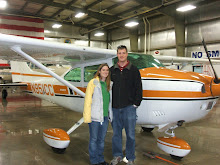Michelle and I had planned to fly to San Diego on December 13th and to Tehachapi on the 14th, but the weather ruined both of those flights. We were hit with a major winter storm system on the 13th and couldn't fly anywhere and the system lingered in the mountains preventing us from flying to Tehachapi on the 14th. Instead, we decided to fly up the valley to Mammoth where I could get some more high altitude practice taking offs and landings.
Flying to Mammoth also was a good opportunity to test my new configuration for recording the flight. I ordered a ground loop isolator which is just a special cord that was supposed to get rid of the alternator noise in the audio, I modified the camcorder mount, and I bought a digital voice recorder so I could have independent audio of the intercom and the cockpit. I also bought a SPOT messenger to track our flights as safety equipment and this was it's first flight as well.
It was a very scenic flight on the way up with the mountains covered with snow, although there was continuous light turbulence, which just got annoying. I didn't leave the video on the entire flight this time, but instead turned it on once and a while to get different scenery and angles. I really liked how some of the side shots turned out.
Unfortunately, even though I got slightly less dash in the view, there was still more than I had hoped for and the angle was low such that I was usually recording below the horizon. The intercom audio still has alternator noise on it, the cabin noise was worse than expected, and I still have the propeller flying off the screen even though I played with the different frame rates. I still have some work to do when editing it to see if I can improve it at all.
Back to the flight itself, the pattern at Mammoth is pretty interesting. There are tall mountains to the south and a smaller ridge to the north. The winds were 10 gusting to 15 knots from the south-west so I flew the right hand pattern around the smaller ridge to runway 27. I thought that I would always maintain sight of the airport, but I soon found out that as I started my descent on downwind, I quickly lost sight of the airport. It's not until your turning final until you see the runway appear from behind the ridge. This caused me some trouble, but I didn't have my approach fully stabilized since i didn't know where the runway was and I couldn't use my standard power settings because of the higher altitude. I ended up being high and fast on the first approach and floated a long ways down the runway. The second time around, I ended up being short and needed significant power to get back on the glide slope by the time I saw the runway. Long story short, I wouldn't feel bad about doing a straight in approach to the uncontrolled airport in the future.
After two time around the pattern, we decided we better head back to Bishop for lunch since we were both getting hungry. After my 3rd not so wonderful landing of the day, we walked into the lobby of the Bishop airport to find that the restaurant was out of business! The airport is also too far from town for us to walk. Fortunately they had a snackbar there and I was rummaging through that until a lady came in looking for the fuel attendant (who was out to lunch at the time). She was very nice and offered us a ride into town and back for lunch since she would have to come back to see the fuel guy after his lunch. She dropped us off at a very good Mexican restaurant named something Amigos and we were able to catch the bus back to the airport (she had thought it wasn't running).
After lunch we headed back to Inyokern where I made one of the nicest landings in several months. Once I finish editing the video from this flight, I'll post the link here. The SPOT messenger worked pretty good, but I'm still not sure what to think about it. On the way there, there was a 100 mile gap in the tracking from Owen's Lake all the way up to Mammoth, although it did have very good tracking the whole way back. It's absolutely better than nothing, but I really wish it didn't have those gaps. I guess more time is needed to tell how reliable it really is.
Subscribe to:
Post Comments (Atom)



No comments:
Post a Comment